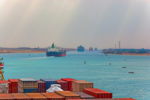
Home » Could Panama Canal Expansion Shift 10 Percent of Asian Container Volume From West Coast to East Coast?
Could Panama Canal Expansion Shift 10 Percent of Asian Container Volume From West Coast to East Coast?

June 23, 2015
The research - which involved extensive scenario analyses based on differing levels of demand, capacity and costs - is believed to be the most comprehensive public study of how the canal’s expansion will likely change the way cargo moves, by both water and land, into and within the U.S. The findings have been released in a report titled Wide Open: How the Panama Canal Is Redrawing the Logistics Map.
The $5bn expansion will permanently alter the competitive balance between ports on the East and West coasts. With global container flows rising, West Coast ports will still handle more traffic than they do today, but they will experience lower growth rates and their market share will likely fall.
Goods shipped from East Asia through West Coast ports are currently transported by rail and truck as far east as the Ohio River Valley. The canal’s expansion will permit big, efficient “post-Panamax” container ships - which have two to three times the capacity of current vessels - to reach the East Coast. Those ports will then become more cost competitive because it is cheaper to move cargo by water than over land. West Coast ports, however, will remain the destination of choice for shippers who need to use the fastest routes possible.
After the Panama Canal expands, the battleground region in which East and West Coast ports compete for customers will likely grow and shift several hundred miles west toward Chicago and Memphis, encompassing a region that accounts for about 15 percent of U.S. GDP.
“With the Panama Canal’s expansion, shippers will have more options and carriers will compete to provide those options,” said Peter Ulrich, a BCG partner and the leader of the firm’s transportation and logistics topic area in North America. “Rail, truck and ocean carriers will all have to reconsider their routing and investment decisions. And shippers will need to make fundamental choices, such as where to locate distribution centers and how to segregate their cargo heading for the heartland.”
In 2014, about 35 percent of container traffic from East Asia to the U.S. arrived at East Coast ports. According to the report, current growth trends would push that share to 40 percent by 2020 without the canal’s expansion. But with the canal expansion in place, the East Coast’s share could reach 50 percent—a 10 percent increase in market share.
The report also analyzed four additional scenarios to help define the boundaries of how much container traffic will swing from West Coast to East Coast ports under different conditions for energy prices, canal tolls, infrastructure investments, and economic growth. High energy prices, for example, encourage fuel-efficient water travel and favor East Coast ports. Depending on the scenario, these shifts ranged from 0 to 10 percent.
Under any scenario, all major U.S. ports will have greater container traffic in 2020 than they do today. But the largest of the West Coast ports, the Los Angeles–Long Beach complex, will handle less traffic than if the expansion were not to occur. That complex will likely experience growth at an average rate of 5 to 10 percent per year through 2020, compared with double-digit growth rates at some East Coast ports.
On the East Coast, the New York–New Jersey port complex and the Southeastern ports of Norfolk, Savannah and Charleston are well positioned to gain traffic by virtue of their relative proximity to the battleground region and attractive rail routes to major markets. As the East Coast’s largest ports, they are also likely to be on the routes of the post-Panamax vessels, which tend to make fewer, longer stops than smaller vessels.
“Companies accustomed to shipping to the West Coast and relying on relatively fast rail service to cover most of the country will need to take a much more segmented and dynamic approach,” said Sri Laxmana, the director of ocean services at C.H. Robinson. “When time is of the essence, that routing may continue to make sense. But for other products, the savings of shipping through the Panama Canal will likely outweigh the extra time in transit.”
Download a copy of the report.
Source: Boston Consulting Group, C.H. Robinson
RELATED CONTENT
RELATED VIDEOS
KEYWORDS BCG C.H. Robinson Global Gateways Global Logistics Industrial Manufacturing Logistics Logistics Management: Ocean Transportation Logistics Outsourcing logistics services Ocean Cargo ocean container traffic Ocean Transportation Transportation & Distribution Transportation Management U.S. import volume U.S. ports
Related Directories
Subscribe to our Daily Newsletter!
Timely, incisive articles delivered directly to your inbox.
Popular Stories

2024 Supply Chain Management Resource Guide: There's Only One Way Off a Burning Platform
VIEW THE LATEST ISSUECase Studies
-
Recycled Tagging Fasteners: Small Changes Make a Big Impact
-

Enhancing High-Value Electronics Shipment Security with Tive's Real-Time Tracking
-

Moving Robots Site-to-Site
-
JLL Finds Perfect Warehouse Location, Leading to $15M Grant for Startup
-
Robots Speed Fulfillment to Help Apparel Company Scale for Growth



